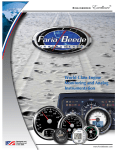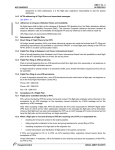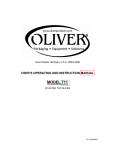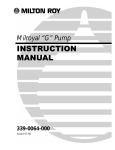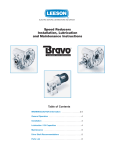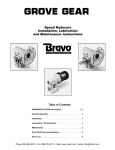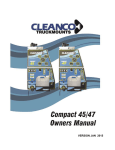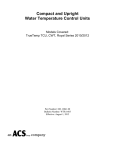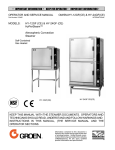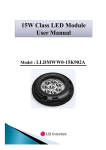Download various (Service Manual)
Transcript
To order this part, call Lifco Hydraulics USA Toll Free at 1-800-952-7849 Flow Meters Installation, Operating & Maintenance Manual To order this part, call Lifco Hydraulics USA Toll Free at 1-800-952-7849 This manual is a service guide produced by the manufacturer and provides specific procedures and/or illustrations for disassembly, assembly, inspection, cleaning, and filtration. When followed properly, these procedures will keep your flow meter in top operating condition. It is important for operators and maintenance personnel to be safety conscious when operating or repairing equipment. Developing a thorough knowledge of the precautionary areas and following safe operating procedures can prevent equipment damage and/or personal injury. Before making any repair, read all of the repair procedures to learn the correct method and all precautions. Table of Contents Specification and General Information Specifications and Basic Application Information . . . . . . . . . . . . . . .3 Warning and Precautionary Areas . . . . . . . . . . . . . . . . . . . . . . . . . . .4 Installation Basic Installation Instructions . . . . . . . . . . . . . . . . . . . . . . . . . . . . . .5 Fluid Flow in Reverse Direction . . . . . . . . . . . . . . . . . . . . . . . . . . . .6 Bi-Directional Flow Measurement . . . . . . . . . . . . . . . . . . . . . . . . . . .6 Operation Operating Principles . . . . . . . . . . . . . . . . . . . . . . . . . . . . . . . . . . . . .7 Reading the Meter . . . . . . . . . . . . . . . . . . . . . . . . . . . . . . . . . . . . . . .8 Specific Gravity or Density Effect . . . . . . . . . . . . . . . . . . . . . . . . . . .8 Viscosity Effect . . . . . . . . . . . . . . . . . . . . . . . . . . . . . . . . . . . . . . . . .9 Pneumatic Meters Uses & Operating Theory . . . . . . . . . . . . . . . .9 Troubleshooting & Maintenance Troubleshooting Chart . . . . . . . . . . . . . . . . . . . . . . . . . . . . . . . . . . .13 Disassembly . . . . . . . . . . . . . . . . . . . . . . . . . . . . . . . . . . . . . . . . . .15 Cleaning and Inspection . . . . . . . . . . . . . . . . . . . . . . . . . . . . . . . . .17 Contamination and Filtration Recommended Filtration . . . . . . . . . . . . . . . . . . . . . . . . . . . . . . . . .18 Stabilized Contamination . . . . . . . . . . . . . . . . . . . . . . . . . . . . . . . . .18 Contamination Sources . . . . . . . . . . . . . . . . . . . . . . . . . . . . . . . . . .18 Interchangeable Floating Orifice Disks Basic Application Information . . . . . . . . . . . . . . . . . . . . . . . . . . . . .19 (2) To order this part, call Lifco Hydraulics USA Toll Free at 1-800-952-7849 Specifications Casing Material Aluminum, Brass or Stainless Steel #304 Maximum Pressure Aluminum and Brass: Stainless Steel #304: 3500 psi (240 Bar) 6000 psi (413 Bar) Maximum Temperature 240ºF (115ºC) Reading Direct Reading - 360º Ref. Line (Non-Electrical) Scale Accuracy +/- 4% FS, Center 1/3 of scale +/- 2.5% FS Repeatability +/- 1% FS Port Sizes 1/8" - 2" NPTF, #6 - #32 SAE (No Brass) 1/4" - 2" BSP Series 2 1/8", 1/4" 1-1/4" O.D. x 4-13/16" Length (32mm O.D. x 122mm Length) Series 3 1/4", 3/8", 1/2" 1-7/8" O.D. x 6-9/16" Length (48mm O.D. x 167mm Length) Installation Dimensions Series 4 (Port Sizes/Dimensions) 3/4", 1" 2-3/8" O.D. x 7-5/32" Length (60mm O.D. x 182mm Length) Series 5 1-1/4", 1-1/2" 3-1/2" O.D. x 10-1/8" Length (90mm O.D. x 258mm Length) Series 5 2" 3-1/2" O.D. x 12-5/8" Length (90mm O.D. x 322mm Length) Installation Orientation Horizontal or Vertical (Scaled Vertically) Flow Straighteners Not Required Test Fluid Mobile DTE 25 Medium @ 110ºF (43ºC) Basic Application Information The flow meter can be installed directly in the fluid line without flow straighteners or special piping. The meter is used to measure the flow rate of most liquids which do not contain particles greater than 74 micron. 1) External components are sealed inside the Lexan window tube to permit use in areas where the meter may be sprayed or washed with soap and water. 2) Mount the meter in the most convenient location to allow easy access for reading and maintenance. 3) The meter should NOT be mounted near hot pipes or equipment which can cause deformation of the window tube and scale. 4) The meter should be mounted at least one foot (.3 meter) from large electric motors, or the internal magnet may weaken or become demagnetized. 5) Aluminum and brass meters should not be mounted where assembled piping is not supported. (3) To order this part, call Lifco Hydraulics USA Toll Free at 1-800-952-7849 Warning and Precautionary Areas 1) The meters are designed to operate in systems that flow in only one direction: the direction of the arrow on the flow scale. Attempting operation in the reverse direction may cause damage to the meter or other system components. (See page 6 for reverse and bi-directional flow information) 2) The window tube of standard meters is made of Lexan. Lexan can be safely cleaned with soap and water. However, many other cleaning agents can damage Lexan, causing discoloration or crazing. If you are unsure of your cleaning agent, call the General Electric Lexan Compatibility Reference Line at 800-845-0600. 3) To retain accuracy and repeatability many internal moving parts are precision machined and require filtration of at least 74 micron or a 200 mesh screen. 4) All meters are tested and calibrated at our test facility using a light hydraulic oil. The units are well drained, but some oil residue may still remain within the meters. Please check the compatibility with your fluid. The meter may have to be cleaned before use. (See “Cleaning & Inspection” section) 5) When installing aluminum or brass meters onto steel pipe caution should be taken not to over tighten the pipe connections. The thread in the meter end fittings may strip if over tightened. 6) Aluminum and brass meters should not be used in systems where the assembled piping is not supported. Heavy weight may cause the meter to bend or malfunction. 7) Operating Temperature: In standard meters, several components have a maximum temperature rating of 240ºF (115ºC). 8) Operating Pressure: All meters are tested at a burst pressure three times of operating pressure. Meters should not be used over the operating pressure rating. 9) Pressure and flow surges may disengage the outer magnet follower from the transfer magnet. If this occurs, a shock suppressor should be used to eliminate malfunction. 10)Teflon tape: Caution should be used when using Teflon tape on pipe thread joints. Leave at least 1/8" (3mm) of pipe thread exposed from end of pipe when applying tape. 11) These meters, as well as many other meters, use an internal transfer magnet in the design. Because of this magnet, be aware of the following: a) Keep flow meters away from computer disks and tapes. b) If metal particles are moving through the system, a magnetic filter may be required. (4) To order this part, call Lifco Hydraulics USA Toll Free at 1-800-952-7849 INSTALLATION Basic Installation Instructions The meters are mounted in-line and are direct reading. The meters can be mounted in a vertical or horizontal position as long as the fluid is flowing in the direction of the arrow on the flow scale. No straight pipe is required before or after the meter. In fact, 90° elbows can be installed on both ends without any noticeable flow variation. When installing a meter, apply “Teflon Tape” or “Liquid Teflon Sealant” on pipe threads. If tape is used, be sure to leave 1/8" (3 mm) of pipe thread exposed on end of pipe. Position filter in front of meter and in a location that allows easy access for routine maintenance. Refer to “Warnings and Precautionary Areas” for additional information. INSTALLATION DOS AND DON'T To obtain satisfactory operation from a Lake flow meter, the following points should be considered: DO: install a pressure gauge near the inlet of the meter place throttling valves at the outlet of the meter use pipe sealer on the connections install a union on one side of the meter for easy removal for maintenance and calibration install solenoid valves at meter outlet (as far downstream as possible) mount in any orientation: vertical, horizontal or upside down DO NOT: place restrictions between the meter’s pressure gauge meter inlet use in systems where reverse flow is possible place meter in non-aligned piping over-flow the meter by more than 150% of maximum reading operate at pressures and temperatures greater than specified *install restrictions between pressure gauges and the meter inlet *install solenoid valves at the meter inlet *pneumatic flow meter applications (5) To order this part, call Lifco Hydraulics USA Toll Free at 1-800-952-7849 Fluid Flow in Reverse Direction The standard meter will not permit flow in the reverse direction (opposite direction to the arrow printed on the flow rate scale). In the reverse direction, the meter will behave in a manner similar to a leaky check valve. Prolonged flow in the reverse direction will cause damage to the standard meter’s internal mechanism that could result in inaccurate readings or premature failure of the meter. If the standard meter will be installed in a system where reverse flow is possible, Lake recommends that a check valve be installed in parallel with the meter in order to facilitate reverse flow around the meter. Check valves are readily available through fluid component distributors. Alternatively, flow meters with a built-in reverse flow bypass mechanism may be specified and ordered for a small additional cost. These meters are designated by a "-RF" suffix attached to the end of the standard 8-digit model code. Flow meters with the built-in reverse flow bypass will allow flows in the reverse direction of up to the maximum flow rate printed on the flow rate scale without any damage to the monitor's internals. If the part number label on the meter that is being installed shows a model code containing the "-RF" suffix, then the meter may be installed in systems where reverse flow is possible without the need for an external check valve. Bi-Directional Flow Measurement In certain situations it may be necessary to measure flow rates in both directions. For a small additional fee, an option for bi-directional flow measurement may be specified. Meters that include this option are designated by a "-BI" suffix attached to the end of the standard 8-digit model code. If the part number label on the meter that is being installed shows a model code containing the "-BI" suffix, then the meter may be installed in any orientation regardless of flow direction. Contact Lake Monitors for more information on reverse and bi-directional flow. (6) To order this part, call Lifco Hydraulics USA Toll Free at 1-800-952-7849 OPERATION Operating Principles Lake has developed a line of unique flow meters which combine the simplicity of a sharp-edged orifice disk and a variable area flow meter. See Illustration 1 “Flow Meter Cross Section” on page 8. The meters are tubular, with all internal wetted parts sealed within the body casing. Running through the center of the body casing is a tapered center shaft which is centered in the bore by pilot disks at each end. Encircling the shaft is a sharp-edged, floating orifice disk, transfer magnet and return spring. The disk and transfer magnet are held in the “no flow” position by the biased return spring. As the flow moves through the meter it creates a pressure differential across the floating orifice disk, forcing the disk and transfer magnet against the return spring. As flow increases, the pressure differential across the disk increases, forcing the disk and transfer magnet to move along the tapered center shaft. As flow decreases, the biased return spring forces the disk and transfer magnet down the tapered center shaft, returning to the “no flow” position. In metal casing meters we cannot see the movement of the floating orifice disk and transfer magnet because they are sealed inside the body casing. Therefore, a magnet follower is positioned around the outside of the body casing and is magnetically coupled to the internal transfer magnet. As the flow rate increases, the internal magnet moves along the tapered center shaft (inside the body casing) and the magnet follower moves along the outside of the body casing (under the scale). (7) To order this part, call Lifco Hydraulics USA Toll Free at 1-800-952-7849 FLOW METER (CROSS SECTION) 3 5 4 Flow n ctio Dire 2 1 13 6 Flow n ctio Dire 7 8 9 10 12 11 Illustration 1 1. End Porting 8. Flowing Sharp-Edged Orifice Disk 2. Body Casing 9. Tapered Center Shaft 3. Magnet Follower 10. Transfer Magnet 4. Window Tube 11. Scale 5. Window Seal 12. Return Spring 6. Seal Assembly 13. Retainer Ring 7. Pilot Disk * Cartridge contains: 7, 8, 9, 10, 12 & 13 Reading the Meter Notice the black reference line which runs 360° around the white magnetic follower. This reference line moves under the scale in direct relation to the movement of the internal orifice disk. When fluid is flowing, the flow rate through the meter is read by lining up the black reference line with the closest rate line on the external flow scale. Specific Gravity or Density Effect Standard meters are calibrated for either WATER with a specific gravity of 1.0 or OIL with a specific gravity of .873. The floating disk meter is effected by fluid density as are most other similar type meters. Lake’s meters have less of this effect because of the sharpness of the floating orifice disks being used. (8) To order this part, call Lifco Hydraulics USA Toll Free at 1-800-952-7849 The indicated flow reading will read high for heavier fluids and low for lighter fluids. A corrective factor can be applied to the standard scale or a special scale can be added at a slight additional costs. When flowing other specific gravities, the basic equations below can be used. For WATER Meters use: 1.0/Specific Gravity x scale reading For OIL Meters use: .873/Specific Gravity x scale reading Viscosity Effect The meters incorporate a unique floating, sharp-edged orifice disk. The floating, sharp-edged orifice disk offers greater operating stability and accuracy over a wide range of viscosities. PNEUMATIC METER USES & OPERATING THEORY Lake’s rugged, high-pressure, pneumatic meters are designed for permanent installation in compressed gas systems. These products provide a low cost means to measure compressor volumetric outputs, pneumatic tool consumptions and other industrial gas flow rates. Lake meters operate using the variable annular orifice method with compression spring return –the identical method used in our field proven liquid flow rate meters. The product’s follower, where the measurement is indicated, is magnetically coupled through a high pressure casing to the meter’s internal orifice assembly. Benefits of these design features are: high operating pressure linear displacement of the follower with respect to flow rate high turn-down ratios measuring accuracy within ±4% of full-scale operation in any mounting orientation Lake meters are offered in three standard materials of construction: aluminum for standard monitoring applications to 600 PSIG brass for media/material compatibility stainless steel for compatibility and operation to 1000 PSIG. (9) To order this part, call Lifco Hydraulics USA Toll Free at 1-800-952-7849 Measuring ranges cover 1.5-12 SCFM through 150-1300 SCFM. Twenty-four port sizes from 1/8" through 2" in NPT, SAE and BSP can be ordered to meet specific plumbing requirements. Lake’s pneumatic meters are also available in alarm and transmitter configurations for electronic monitoring applications. Standard Cubic Feet Lake’s meter are calibrated to measure the flow of compressible media (gases) in SCFM – standard cubic feet per minute. A “standard” cubic foot is defined as a cubic foot of dry air at standard atmospheric conditions: 70ºF and 14.7 PSIA (0 PSIG) measured at sea level. When a standard cubic foot of air is compressed, its actual volume will decrease proportionally as absolute pressure increases. For example, a standard cubic foot of air’s actual volume will decrease by 50% and density will increase by 100% as the air is compressed from atmospheric pressure 14.7 PSIA (0 PSIG) to 29.4 PSIA (14.7 PSIG). See Illustration 2. There are three factors that affect the Flow Meter Calibration: specific gravity, pressure and temperature. Lake meters are calibrated for air (specific gravity of 1.0) at 70ºF and 100 PSIG. Most low pressure rotameters are calibrated at 0 PSIG and require corrections for use at any other pressure. 14.7 PSIA (0 PSIG) 29.4 PSIA (14.7 PSIG) 58.8 PSIA (44.1 PSIG) Lake products are designed for pneumatic systems where pressures between 90 -110 Illustration 2 PSIG are used. In these common applications, a Lake monitor with a standard calibration can be read directly without applying corrections. (10) To order this part, call Lifco Hydraulics USA Toll Free at 1-800-952-7849 DENSITY CORRECTION FACTORS SCFM (indicated) x (CF) = SCFM (Actual) CF= (F1) x (F2) X (F3) Note: all correction factors need not be used. Table 1. (f1) PRESSURE CORRECTION FACTORS (inlet pressure) psig 25 f1 .56 50 75 100 125 150 175 200 .75 .88 1.0 1.11 1.2 1.29 1.37 f1 = 14.7 + psig 114.7 Table 2. (f2) TEMPERATURE CORRECTION FACTORS ºF f2 10º 30º 50º 70º 90º 110º 130º 150º 1.08 1.04 1.02 1.0 .98 .96 .95 f2 = .93 530 460 + ºF Table 3. (f3) SPECIFIC GRAVITY CORRECTION FACTOR f3 = 1 Sp. Gr. f1= correction factor for other than 100 PSI inlet. f2= correction factor for other than 70ºF. f3= correction factor for other than air at 1.0 Sp. Gr. Correction Factors If a Lake meter is installed in a system where conditions differ from the standard listed above, correction factors will need to be applied to retain the design accuracy of the meter. The appropriate correction factor equations are detailed above. To assure the best monitoring accuracy, pressure and temperature measurements should be taken directly at the meter’s inlet port. Special Scales Special calibrations can be performed by Lake Monitors to correct for the following system characteristics: system pressure system temperature media specific gravity various measuring units (i.e. LPM, LPS, m3/hr, etc.) any combination of the above Consult Lake’s factory or your distributor for details and prices. (11) To order this part, call Lifco Hydraulics USA Toll Free at 1-800-952-7849 Selecting the Proper Meter To order a pneumatic flow meter the following information is required: pipe size and port style media (air, nitrogen, argon,etc.) – for material compatibility and specific gravity considerations approximate flow range required1 system pressure: nominal, maximum, minimum system temperature Flow Range1 Estimating the flow rate in a compressed gas system may seem complicated, but with some research and a few simple equations an educated guess can be made. Two suggested methods are: Method 1 A compressor is typically rated in SCFM output at a certain pressure and efficiency. If the rating cannot be located or is unknown, an estimate of compressor output can be obtained by the following formulas: 1-stage compressors: motor HP/0.179 = SCFM @ 100 PSIG 2-stage compressors: motor HP/0.164 = SCFM @ 100 PSIG 3-stage compressors: motor HP/0.159 = SCFM @ 100 PSIG Method 2 If all of the potential of a compressor is not being used (the unit cycles on and off) or if flow rate in excess of compressor capacity is being consumed (the compressor cannot meet the demand), a summation of machine usages can be totaled to determine the maximum flow rate. Most machine tools that use compressed air specify the maximum consumption of the tool. (12) To order this part, call Lifco Hydraulics USA Toll Free at 1-800-952-7849 TROUBLESHOOTING & MAINTENANCE TROUBLESHOOTING CHART Malfunction: Magnet follower sticks in mid-scale and will not return to the “no flow” position. Possible Cause: Corrective Action: Horizontal/Vertical Mount Particulate, Teflon tape, rust or other foreign matter is holding the internal parts form returning. Disassemble and inspect meter for contamination. Install proper filtration or problem may reoccur. Horizontal/Vertical Mount A surge or shock in the fluid flow moved the internal magnet faster that the external follower could follow, thus separating the follower from the magnet. Warning: Shut down systems before removing meter from flow line. Remove meter from system. Tip the meter so the arrow on the flow scale points upward. This should return the magnet follower to the “no flow” position. Add some type of surge protection, or problem my reoccur. Malfunction: Meter scale reading is off an equal amount at all points and the magnet follower still moves freely. Possible Cause: Corrective Action: Reading the scale using the top or bottom edge of the magnet follower. Be sure to read the scale using the black reference line which runs around the magnet follower. Possible Cause: Corrective Action: Fluid being monitored may not be compatible with standard meter scale. Standard meters are calibrated for .873 SP. Gr. oil at 110° (43°C) using Mobile DTE 25 Medium fluid. Check your fluid data for a variance, or call the factory for assistance. Possible Cause: Corrective Action: All meters are calibrated in the vertical Check with the factory for a correction position. factor or for a replacement scale corrected for horizontal use. (13) To order this part, call Lifco Hydraulics USA Toll Free at 1-800-952-7849 TROUBLESHOOTING CHART (CONTINUED) Malfunction: Window tube is cracking or crazing. Possible Cause: Corrective Action: Using incompatible cleaning solution on Lexan window tube. Use soap & water or a mild degreaser (Stoddard or Naptha) to clean Lexan tube. To check the compatibility of your cleaning fluid, call General Electric’s Lexan Compatibility Reference line at 800-845-0600. Malfunction: Scale is fogging or coming loose. Possible Cause: Corrective Action: Ambient or fluid temperature is too high. Relocate meter in another area where temperature specifications are not being exceeded. Possible Cause: Corrective Action: Using incompatible cleaning solvents on scale. Use soap and water. (14) To order this part, call Lifco Hydraulics USA Toll Free at 1-800-952-7849 Disassembly Important: It is not necessary to remove window tube or window seals to clean the meter. Note also how the meter disassembles for easy of reassembly. Warning: Shut down system before removing meter from flow line. 1. Use a clean dry cloth to remove all foreign material from exterior of meter, especially around threaded ends. Illustration 3 2. Remove meter from the flow line. 3. With the arrow on the scale pointing upward, mount the meter in a vice. See Illustration 3. Use the flats of the inlet end porting when securing the meter in the vice. Important: DO NOT wrench or tighten vice on Lexan tube. 4. Install a wrench across the flats of the outlet end porting and turn counterclockwise to loosen assembly. Do not remove end porting at this time. 5. Remove meter from vice. Hold the meter so the end port that is loose, is on top. Remove loose end porting. 6. Tilt the open end of meter Illustration 4 over a clean cloth to expose inner cartridge. See Illustration 4. Remove inner cartridge assembly from body casing. Note: Because the transfer magnet is magnetically coupled to the magnetic follower, you will notice a slight resistance when removing cartridge. If cartridge does not slide out, insert a wooden dowel in opposite end of meter and push or lightly tap on dowel until cartridge comes loose. (15) To order this part, call Lifco Hydraulics USA Toll Free at 1-800-952-7849 IMPORTANT: If inner cartridge does not slide out freely, it may be sign of contamination. The transfer magnet is a powerful ALNICO magnet. Keep it away from metal chips and fillings. They may be hard to remove when reassembling and will cause premature failure. 7. Examine inner cartridge or level of contamination. A. If inner cartridge has a low level of contamination and is functioning properly, no further disassembly is required. Proceed to “Cleaning and Inspection.” See Illustration 5. B. If inner cartridge appears to be highly contaminated or damaged, it should be completely disassembled for cleaning and inspection. Proceed with Step 8. Illustration 5 8. Remove outlet side (spring end) retainer clip, See Illustration 6, which secured pilot disk to tapered center shaft. Illustration 6 9. Remove return spring, transfer magnet and floating orifice disk. See Illustration 7. 10. Proceed to “Cleaning and Inspection.” After the meter is cleaned reassemble parts in reverse order of disassembly. Illustration 7 IMPORTANT: Always use new retainer clips for reassembly. 3/8" and 1/2" = Waldes No. 5105-12H. 3/4 and 1" and 1-1/4" and 1-1/2" = Waldes No. 510518H, or obtain at no charge from the factory. (16) To order this part, call Lifco Hydraulics USA Toll Free at 1-800-952-7849 Cleaning and Inspection Note: If the inner cartridge is damaged or contaminated beyond repair, the complete meter can be sent to the manufacturer for evaluation. The manufacturer will inspect, repair, and/or replace parts as needed according to the warranty. 1. Inspect inner cartridge and body casing for contamination. If the inner cartridge did not slide out freely, it may be a sign of contamination. Locate and eliminate the source of contamination before reconnecting meter to the system or the same problem will reoccur. It may be necessary to install finer filtration or a magnetic filter in the system. 2. Soak inner cartridge assembly (or individual parts, depending on level of disassembly) in a suitable cleaning solvent. Naptha or Stoddard is recommended. CAUTION: When using an air hose wear proper eye protection. 3. Remove parts from solvent. Use an air hose and/or scrub with a light brush to remove any remaining contaminants. Remove any magnetized particles from transfer magnet. 4. Inspect inner cartridge for scored or worn parts. Replace parts as needed. (Parts are available from your local distributor.) 5. Remove any contaminants from inside body casing. 6. Clean Lexan widow tube with soap and water, or a compatible cleaning solvent. IMPORTANT: Some solvents may cause damage to Lexan tube, check compatibility of solvent being used. 7. Clean and inspect seal assemblies (O-rings and seals) for nicks or cuts. Replace as needed. 8. Clean and inspect the meter every six months. Properly filtered meters will provide years of trouble-free service. If the meter is not properly filtered, it may be damaged and malfunction. Meter damage caused by excessive contamination in not covered under warranty. (17) To order this part, call Lifco Hydraulics USA Toll Free at 1-800-952-7849 CONTAMINATION AND FILTRATION Recommended Filtration The manufacturer recommends system filtration of at least 74 micron filter or a 200 mesh screen. It has been found that if inadequate filtration has caused meter failure, it will normally fail in the open position. Some systems may require a magnetic filter. IMPORTANT: Meter damage caused by excessive contamination is not covered under warranty. Stabilized Contamination The goal of filtration is to create effective protection from system contamination. Proper filtration stabilizes contamination to allow fluid components to function properly. A fluid system is considered stabilized when, “contamination in” equals “contamination out”. Proper filtration must reduce initial contamination to a stabilized level within an acceptable time period. the system should be stabilized in time to prevent premature wear or damage to meter components. Contamination Sources Fresh Fluid When fresh fluid is stored in holding tanks, it may be contaminated with scale or metal flakes from inside the tank. To prevent this type of contamination, be sure to filter fresh fluid before adding to the system. New Machinery Contamination When building new machines, a certain amount of built-in contamination is unavoidable. Typical built-in contamination consists of dust, dirt, chips, fibre, sand, flushing solutions, moisture, weld splatters and pipe sealants. Flushing the system before operation can reduce contamination, but cannot eliminate it totally. Unless the system is flushed at a high velocity, some contamination will not be dislodged until the system is in operation. System contamination can cause fluid component malfunction. Environmental Contamination When performing routine maintenance, the system’s fluid is commonly exposed to environmental contamination. Exercise caution during routine maintenance to prevent this type of contamination. Be sure to change breather filter and systems air filter regularly. (18) To order this part, call Lifco Hydraulics USA Toll Free at 1-800-952-7849 Self-Generation Contamination Self-generated contamination is a product of wear, cavitation, fluid breakdown and corrosion. Systems that are carefully flushed, maintained, and have fresh fluid added, mainly have self-generated contamination. In this case, proper filtration can prevent fluid component malfunction. INTERCHANGEABLE FLOW CARTRIDGE Basic Application Information This unique design permits the exchange of many different cartridges within the same meter, thus, allowing the conversion to other flow ranges at minimal cost. The substitute cartridge offers different flow ranges at the same low pressure drop as the original. Each cartridge comes with a new cartridge, scale and installation instructions. Check with your Lake Monitors distributor for prices and delivery. (19) To order this part, call Lifco Hydraulics USA Toll Free at 1-800-952-7849 For downloadable product manuals, data sheets and CAD drawings, visit Lake’s web site today! www.lakemonitors.com LAKE MONITORS INC. 2013 SOUTH 37TH STREET MILWAUKEE, WI 53215 P: (800) 850-6110 (414) 671-3577 F: (414) 671-5253 WWW.LAKEMONITORS.COM LFMM-1205 © Lake Monitors Inc. 2005




















